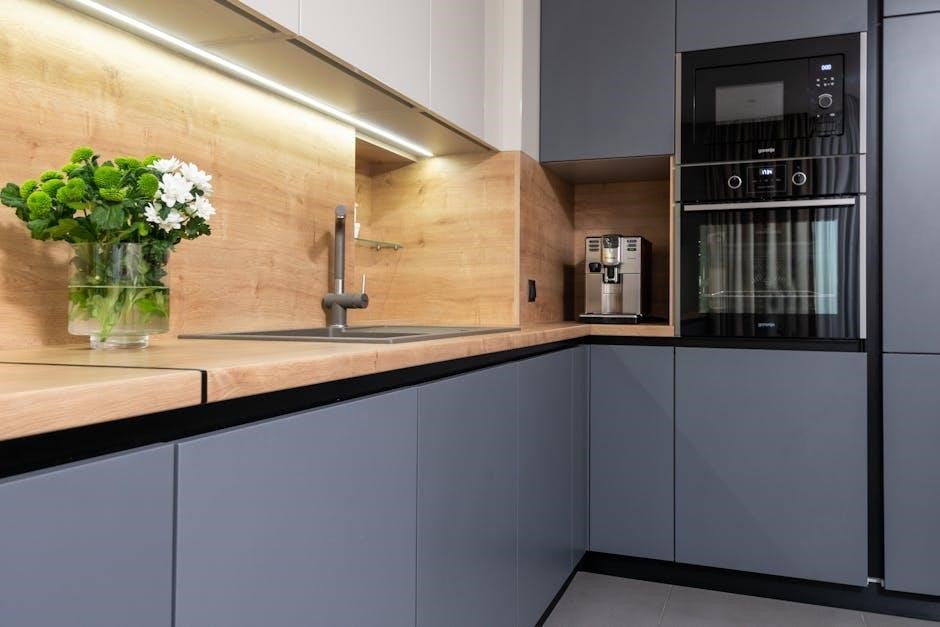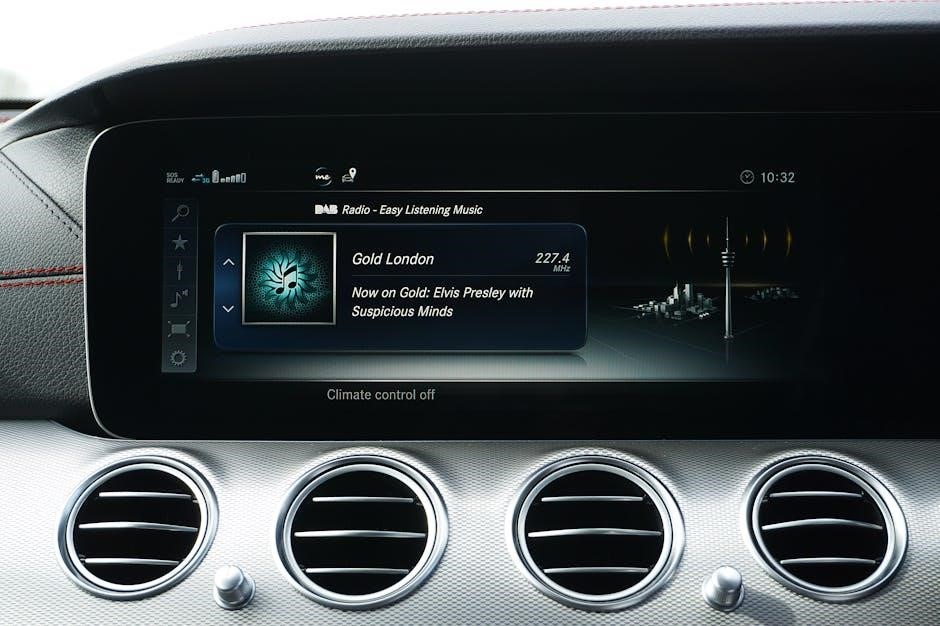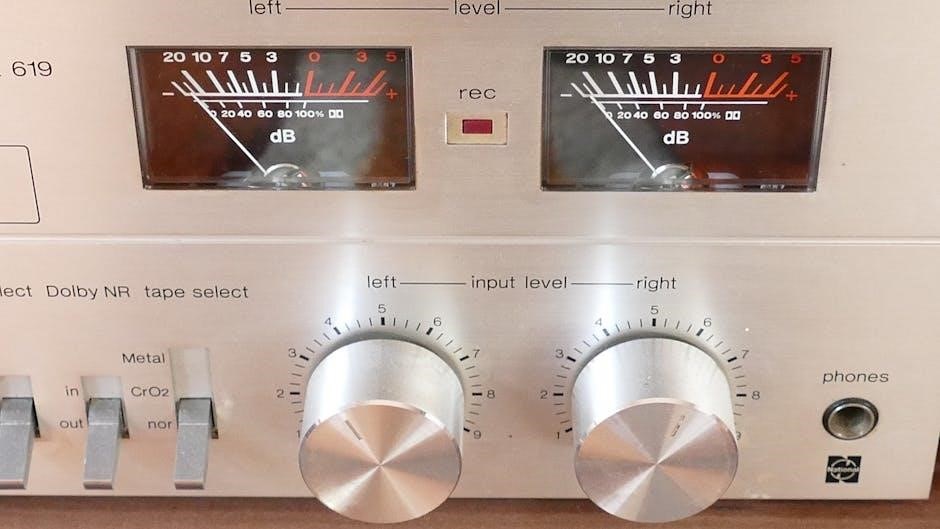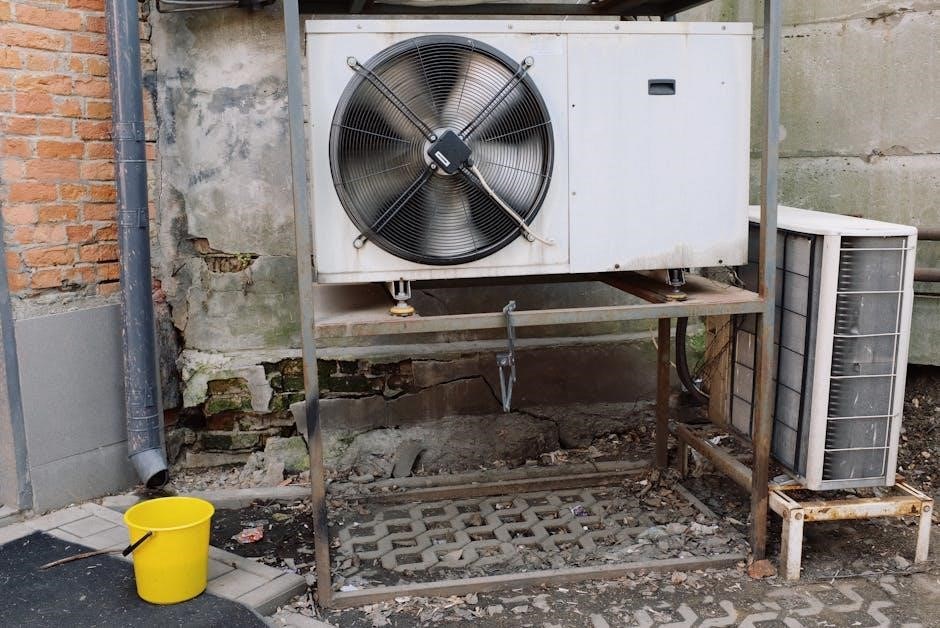Control Panel Components
The control panel features an LCD display for easy operation, showing temperature, mode, and error codes. It includes functional buttons to adjust settings and select modes. A remote controller is provided for convenient operation; LED indicators signal system status, errors, and active functions, ensuring clear monitoring and control.
1.1 LCD Display
The LCD display on the Daikin air conditioner control panel serves as the central interface for monitoring and adjusting settings. It provides real-time information about the unit’s operation, including the current temperature, set temperature, operation mode, fan speed, and air swing direction. The display also shows timer settings, error codes, and remote control signals, ensuring users are informed about the system’s status at all times.
The LCD screen is backlit for enhanced visibility, even in low-light conditions, and features a 4-line, 20-character layout. This allows for clear and organized presentation of data, making it easy to navigate through settings and modes. The display updates dynamically as adjustments are made, providing immediate feedback to user inputs.
Key information displayed includes:
- Current and set temperature values
- Active operation mode (Cool, Heat, Fan, Auto)
- Fan speed settings (Low, Medium, High, Auto)
- Air swing position and automatic swing status
- Timer activation and remaining time
- Error codes for troubleshooting
- Remote control signal reception status
The LCD display is essential for seamless operation and troubleshooting. Users can rely on it to monitor performance and make necessary adjustments efficiently. Regularly checking the display helps ensure optimal functionality and energy efficiency. Always refer to the LCD for system updates and maintenance alerts to keep the air conditioner running smoothly.
1.2 Buttons and Their Functions
The Daikin air conditioner control panel is equipped with a variety of buttons designed to provide easy and intuitive control over its functions. Each button serves a specific purpose, allowing users to customize their experience based on their preferences and needs. Below is a detailed explanation of the buttons and their functions:
- Operation Mode Selector Button: Press this button to cycle through the available operation modes, including Cool, Heat, Fan, and Auto modes. The selected mode will be displayed on the LCD screen for confirmation.
- Temperature Adjustment Buttons: Use the “+” and “-” buttons to increase or decrease the set temperature. These buttons allow precise control over the desired temperature, ensuring comfort and efficiency.
- Fan Speed Button: This button enables users to adjust the fan speed, with options typically including Low, Medium, High, and Auto. The Auto setting allows the system to automatically regulate fan speed based on the current operation mode.
- Swing Button: The Swing button activates the automatic air swing function, which distributes air evenly across the room. Users can also press and hold this button to manually adjust the air direction by stopping the louvers at a specific position.
- Timer Button: This button allows users to set a timer for the air conditioner to turn on or off automatically. The timer function is particularly useful for energy management and ensuring the system operates only when needed.
- Power Button: Located prominently on the control panel, the Power button is used to turn the air conditioner on and off. Pressing it once starts the unit, while pressing it again shuts it down.
- Econo Mode Button: The Econo Mode button activates energy-saving features, optimizing the system’s performance to reduce power consumption while maintaining comfort levels.
These buttons are designed to provide seamless control over the air conditioner’s operations, ensuring users can easily customize their settings to suit their needs. By familiarizing themselves with the functions of each button, users can maximize the efficiency and comfort provided by their Daikin air conditioner.
1.3 Remote Controller Overview
The Daikin air conditioner remote controller is a convenient and essential component for operating the unit. It allows users to adjust settings, select modes, and monitor the system from a distance. The remote is designed with a user-friendly interface, featuring a range of buttons that correspond to specific functions. Key buttons include the power button to turn the unit on and off, mode selection buttons for Cool, Heat, Fan, and Auto modes, and temperature adjustment buttons to set the desired temperature. Additionally, the remote includes buttons for fan speed control, air swing adjustment, and timer settings. Some models may also include advanced features, such as an Econo Mode button for energy-saving operation.
To use the remote effectively, ensure it is pointed directly at the indoor unit’s infrared receiver. Batteries should be replaced promptly when the remote’s functionality diminishes. The remote controller also displays the current settings and mode on its LCD screen, providing clear feedback to the user. For detailed instructions on specific button functions, refer to the user manual provided with the air conditioner. The remote controller is a vital tool for maximizing the performance and efficiency of the Daikin air conditioner, offering ease of use and precise control over all functions;
1.4 LED Indicators and Lights
The Daikin air conditioner control panel is equipped with LED indicators and lights that provide essential feedback about the system’s operational status. These LEDs are strategically located on the control panel to ensure easy visibility and understanding. The LEDs serve as visual cues for various functions, modes, and potential issues, helping users monitor and troubleshoot the system effectively.
Key LED indicators include those for power status, operation mode, error detection, and specific features. For instance, a green LED may indicate normal operation, while a red LED could signal an error or malfunction. Some models also feature LED indicators for active functions like automatic air swing or powerful mode. Additionally, certain LEDs may flash to alert users of issues such as system errors or maintenance requirements.

The LEDs are complemented by error codes displayed on the LCD screen, which provide detailed information about specific problems. For example, codes like “E1” or “E2” correspond to particular issues, such as sensor malfunctions or communication errors. By referencing the user manual, users can interpret these codes and address the underlying causes. This combination of LED indicators and error codes ensures comprehensive system monitoring and efficient troubleshooting.
Overall, the LED indicators and lights on the Daikin air conditioner control panel are designed to enhance user experience by providing clear, real-time feedback. They play a crucial role in maintaining optimal system performance and ensuring prompt resolution of any operational issues.

Operation Modes
The Daikin air conditioner offers four primary operation modes: Cool Mode for cooling, Heat Mode for heating, Fan Mode for air circulation, and Auto Mode for automatic temperature adjustment. Users can select these modes via the remote controller or control panel, ensuring optimal comfort based on their needs. Each mode is designed for specific environmental conditions.
2.1 Cool Mode

Cool Mode is designed to lower the room temperature, providing a refreshing environment. To activate this mode, press the Mode button on the remote controller or control panel until Cool is displayed on the LCD screen. The system will begin cooling the air, and you can adjust the temperature using the Up and Down buttons. The temperature range for Cool Mode typically spans from 62°F to 90°F (17°C to 32°C). For optimal performance, ensure the airswing is set to Auto to distribute cool air evenly across the room.
Fan speed can be adjusted during Cool Mode by pressing the Fan Speed button, with options ranging from Low, Medium, High, or Auto. The Auto setting allows the unit to automatically adjust fan speed based on the current temperature. Additionally, the Powerful button can be pressed for faster cooling, ensuring the room reaches the desired temperature quickly. This feature is particularly useful during extreme heat or when rapid cooling is needed.
For energy efficiency, the air conditioner may enter an Energy-Saving operation after reaching the set temperature. During this phase, the system may raise the temperature slightly to reduce energy consumption while maintaining comfort. To exit Cool Mode, press the Mode button again and select a different operation mode, such as Fan or Auto. Always refer to the remote controller manual for detailed instructions on customizing settings for your comfort needs.

2.2 Heat Mode
Heat Mode is designed to warm the room to a comfortable temperature during colder months. To activate this mode, press the Mode button on the remote controller or control panel until Heat is displayed on the LCD screen. The system will begin heating the air, and you can adjust the temperature using the Up and Down buttons. The temperature range for Heat Mode typically spans from 62°F to 90°F (17°C to 32°C). For optimal performance, ensure the airswing is set to Auto to distribute warm air evenly across the room.
Fan speed can be adjusted during Heat Mode by pressing the Fan Speed button, with options ranging from Low, Medium, High, or Auto. The Auto setting allows the unit to automatically adjust fan speed based on the current temperature. Additionally, the Powerful button can be pressed for faster heating, ensuring the room reaches the desired temperature quickly. This feature is particularly useful during extreme cold or when rapid heating is needed.
For energy efficiency, the air conditioner may enter an Energy-Saving operation after reaching the set temperature. During this phase, the system may lower the temperature slightly to reduce energy consumption while maintaining comfort. To exit Heat Mode, press the Mode button again and select a different operation mode, such as Fan or Auto. Always refer to the remote controller manual for detailed instructions on customizing settings for your comfort needs.
2.3 Fan Mode
Fan Mode operates the air conditioner as a fan, circulating air without cooling or heating. This mode is ideal for maintaining air circulation, reducing stagnation, or lowering humidity slightly. To activate Fan Mode, press the Mode button on the remote or control panel until Fan is displayed on the LCD screen. The unit will begin operating the fan at a default speed, which can be adjusted using the Fan Speed button or the Up and Down arrows.
The fan speed options typically include Low, Medium, High, and Auto. In Auto mode, the system automatically adjusts the fan speed to maintain consistent airflow. Additionally, the Swing button can be pressed to activate the automatic air swing function, which distributes air evenly throughout the room by moving the louvers. This ensures a uniform circulation of air without focusing on a specific direction.
Fan Mode is energy-efficient and suitable for mild weather conditions where cooling or heating is unnecessary. It is also useful for ventilating the room or removing stale air. To exit Fan Mode, press the Mode button again and select a different operation mode, such as Cool, Heat, or Auto. For further customization, refer to the remote controller manual or the control panel instructions to explore additional settings and features. Always ensure the air conditioner is set to Fan Mode when no temperature adjustment is needed to optimize energy usage.
2.4 Auto Mode
Auto Mode is an intelligent feature that allows the air conditioner to automatically select the most suitable operation mode based on the room temperature. This mode ensures optimal comfort by switching between cooling, heating, or fan operation as needed. To activate Auto Mode, press the Mode button on the remote controller or control panel until Auto is displayed on the LCD screen. The system will then continuously monitor the room temperature and adjust its operation to maintain the set temperature.
In Auto Mode, the air conditioner uses advanced sensors to detect temperature changes and humidity levels. It prioritizes energy efficiency while maintaining a comfortable environment. For instance, if the room temperature rises above the set point, the system will automatically switch to Cool Mode. Conversely, if the temperature drops below the set point, it will switch to Heat Mode. When the desired temperature is reached, the system may switch to Fan Mode to circulate the air without active cooling or heating, saving energy while maintaining air quality.
Users can set their preferred temperature using the Up and Down buttons on the remote controller or control panel. The system will then adjust its operation to achieve and maintain this temperature. Auto Mode is particularly useful for maintaining consistent comfort levels without manual intervention, making it ideal for everyday use or in situations where temperature fluctuations are expected.
While in Auto Mode, the air conditioner may also activate additional features, such as the Automatic Air Swing function, to ensure even air distribution. For more detailed settings or to customize the operation, refer to the remote controller manual or the control panel instructions. Auto Mode is designed to provide a seamless and energy-efficient experience, adapting to the room’s conditions to deliver optimal performance and comfort.

Additional Features
Additional features enhance functionality and comfort. Automatic Air Swing distributes air evenly. Powerful Mode accelerates cooling or heating. Timer Function allows scheduling operations. These features optimize performance, energy efficiency, and user convenience, providing a tailored experience for diverse needs and preferences.
3.1 Automatic Air Swing
The Automatic Air Swing function enhances air distribution by adjusting the louvers to direct airflow in multiple directions. This feature ensures even cooling or heating across the room, improving comfort and efficiency. To activate it, press the SWING button on the remote controller. The louvers will automatically move to pre-set positions, distributing air uniformly. For precise control, press the SWING button again to stop the louvers at the desired angle. This function is particularly useful for large spaces or areas with varying temperature zones, as it helps maintain a consistent environment. By optimizing airflow, the Automatic Air Swing feature not only enhances comfort but also contributes to energy efficiency by reducing the need for constant temperature adjustments.
3.2 Powerful Mode
The Powerful Mode is a feature designed to rapidly cool or heat the room by increasing the fan speed and compressor operation. This mode is ideal for quickly achieving the desired temperature, especially in extreme weather conditions. To activate Powerful Mode, press the dedicated button on the remote controller. The system will immediately switch to high-speed operation, ensuring faster cooling or heating. This feature is particularly useful for large spaces or when you need immediate temperature adjustment.
Once activated, the air conditioner operates at maximum capacity, prioritizing speed over energy efficiency. The LED indicators on the control panel will light up to confirm that Powerful Mode is engaged. For energy-conscious users, it is recommended to use this mode sparingly, as it consumes more power than standard operation. However, it is a valuable option for situations where rapid temperature control is essential. After achieving the desired temperature, you can switch back to a more energy-efficient mode to maintain comfort while reducing energy consumption.
Powerful Mode complements the air conditioner’s performance, offering a balance between convenience and efficiency. By leveraging advanced technology, Daikin ensures that this feature enhances user experience without compromising overall system reliability. Always refer to the user manual for specific instructions on using this mode effectively and safely.
3.3 Timer Function

The Timer Function on your Daikin air conditioner allows you to set specific times for the unit to turn on or off, providing convenience and energy efficiency. To use this feature, press the Timer button on the remote controller. Use the up and down arrows to set the desired time for activation or deactivation. This feature is ideal for programming the air conditioner to start cooling or heating before you arrive home or to turn off when you leave, helping to reduce energy consumption.
The timer can be set in 1-hour increments, with a maximum setting of 24 hours. Once programmed, the air conditioner will automatically switch on or off at the specified time. You can also cancel the timer at any time by pressing the Timer button again. This function is particularly useful for maintaining a comfortable environment while optimizing energy usage.
Additionally, the timer function integrates seamlessly with other modes, allowing you to combine it with features like Cool, Heat, or Auto Mode for enhanced control. For detailed instructions on setting the timer, refer to the user manual provided with your Daikin air conditioner. By utilizing the Timer Function, you can enjoy a more efficient and convenient cooling or heating experience.

Safety Precautions and Troubleshooting
Always follow safety guidelines when installing and using your Daikin air conditioner. Avoid placing it in areas with mineral oil, salt, or sulfur. Never touch the unit or remote with wet hands. Ensure proper earthing to prevent electrical issues. Refer to the manual for common error codes and troubleshooting steps. Regular maintenance is essential for optimal performance. Professional installation is recommended for safety.
- Error Code E1: Indoor sensor malfunction. Check wiring connections.
- Error Code E2: Outdoor sensor issue. Ensure sensor is clean.
- Error Code E3: Communication failure between indoor and outdoor units. Restart the system.

4.1 Installation Warnings
Ensure proper installation to avoid hazards and ensure optimal performance. Install the air conditioner in a well-ventilated area, avoiding locations with mineral oil, salt, or sulfur. Never install near hot springs or factories with unstable power voltage. The unit must be grounded correctly to prevent electric shocks. Use a dedicated power circuit to avoid overloads.
- Location Restrictions: Avoid coastal areas, cutting oil environments, or places with high sulfur levels.
- Power Supply: Ensure the power voltage matches the unit’s specifications to prevent damage.
- Professional Installation: Only qualified technicians should install the unit, adhering to safety regulations.
- Post-Installation Checks: Test the system to ensure proper operation and address any leaks or electrical issues.
Always follow the manufacturer’s guidelines and local safety standards. Improper installation can lead to water leakage, electrical hazards, or reduced efficiency. Keep the installation manual handy for future reference and ensure the owner understands safety precautions.
4.2 Usage Precautions
Adhere to these guidelines to ensure safe and efficient operation of your Daikin air conditioner. Never touch the unit or remote controller with wet hands, as this may cause electrical shock or damage. Avoid exposing the air conditioner to direct water or excessive moisture. Keep the remote control dry and away from extreme temperatures.
- Electrical Safety: Ensure the unit is properly grounded and avoid overloading circuits. Use a dedicated power supply to prevent voltage fluctuations.
- Proper Usage: Do not block air vents or grilles, as this can reduce efficiency and cause malfunctions. Avoid using the air conditioner in areas with hazardous gases or flammable materials.
- Maintenance: Regularly clean filters to maintain airflow and energy efficiency. Avoid using harsh chemicals or abrasive cleaners, as they may damage components.
- Temperature Settings: Set realistic temperature ranges (between 17°C and 30°C) to avoid overloading the system. Using the timer function can help optimize energy usage.
- Handling: Do not attempt to repair the unit yourself. Contact a qualified technician for any maintenance or repairs.
Additionally, never use the air conditioner in extreme conditions, such as freezing temperatures or near open flames. Always follow the manufacturer’s guidelines for operation and maintenance. Proper usage ensures longevity, safety, and optimal performance of your Daikin air conditioner.

4.3 Common Error Codes
Understanding error codes is essential for troubleshooting your Daikin air conditioner. These codes help identify issues quickly and guide you toward solutions. Below are some common error codes and their meanings:
- E1: Indicates a communication error between the indoor and outdoor units. Check wiring connections and ensure proper installation.
- E2: Signals a high-pressure error. This may occur due to refrigerant issues or blockages in the system. Contact a qualified technician for assistance.
- E3: Refers to a low-pressure error, often caused by refrigerant leaks or sensor malfunctions. Professional inspection is recommended.
- E4: Indicates a temperature sensor error. This could be due to faulty sensors or wiring problems. Check connections and replace sensors if necessary.
- E5: Points to a drain error. Ensure the drain pipe is clear and properly installed to avoid water leakage issues.
- E6: Signals a fan motor error. This may be due to overheating or mechanical failure. Allow the unit to cool down or replace the motor if damaged.
- E7: Indicates a compressor error. This could be caused by excessive load or internal component failure. Contact a technician immediately to prevent further damage.
- E8: Refers to a remote control signal error. Ensure the remote is paired correctly and has working batteries. If issues persist, reset the system.
- E9: Signals a system malfunction. This is a generic error code requiring professional diagnosis and repair.
Always refer to your Daikin air conditioner’s manual for specific error code explanations and solutions. If issues persist, contact a certified Daikin technician to ensure proper repairs and maintain warranty validity.
